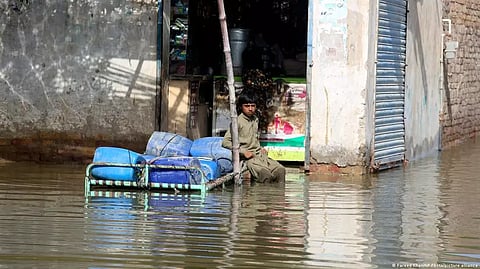

By Serdar Vardar
WASHINGTON: The cryosphere, which refers to the frozen parts of the planet, currently comprises almost 10% of the Earth’s surface. But as rising temperatures from human-caused emissions melt ice caps, glaciers and sea ice, it has become a percentage in decline. “In the last two years we have lost a gigantic part of the Antarctic Sea Ice,” said Antje Boetius the director of German polar research hub, and co-Chair of the Scientific Advisory Board of the summit. “All parts of the cryosphere, in the last three years, have exceeded the predicted range of change last forecast by the Intergovernmental Panel on Climate Change (IPCC),” she said.
It’s a loss that has potential impacts for billions of people around the world in myriad ways. Currently at least 1.9 billion people are estimated to depend on fresh water from snow and glacier melt that is carried downstream for drinking and agricultural irrigation. As glaciers melt due to warmer temperatures, they initially release more water, but eventually supplies dwindle.
Changes in the cryosphere can alter atmospheric circulation patterns, leading to extreme snow and rainfall, which in turn can cause flash floods and glacial lake outbursts. In Pakistan, unprecedented flooding as a result of extreme monsoon rains and melting glaciers killed more than 1,700 people last summer. More than 2 mn people lost their homes and the total damage was estimated at over $15 bn per World Bank. Equally, as ice melts, sea levels in certain regions rise. According to a study published in the scientific journal, Nature, the homes of up to 410 million people living in coastal areas and on low-lying islands could be affected by an increasing frequency of flooding resulting from rising seas by 2100.
The first ever summit devoted to melting ice sheets aims to bring together researchers and scientists from over 40 glacial and polar nations to share their findings with other experts and political leaders from countries “present in the Arctic, Antarctic and glacial worlds.”
Boetius hopes the Paris meeting, which comes just before the 28th UN climate conference (COP28), will serve as a platform to convince politicians to speed up their efforts to reach climate neutrality and “absolutely engage with biodiversity goals.” She says the loss of Antarctic sea ice has already prevented breeding in some penguin colonies. Other species are also at risk of habitat loss due to melting ice.
“The best outcome of the summit would be for the heads of state present to make a clear statement and communicate the urgency of absolutely committing to the Paris climate goals,” Boetius said. The central aim of the Paris Agreement, a legally binding international treaty on climate change signed by 195 parties, is to keep global temperatures below 2 degrees Celsius, and pursue efforts to limit the increase to 1.5 degrees above pre-industrial levels.
Boetius is also calling for agreement on greater scientific research “to beat the pace of cryospheric change,” thereby allowing countries and communities to be better prepared in the face of glacier collapse and unpredictable snowfall. “Even well-adapted countries like Norway have lost people time and again,” she said. “There is no scaled-up risk monitoring, risk assessment and risk warning for people.”
Citing international cooperation on tsunami early-warning systems in Indonesia, Boetius said a similar approach could be used to predict extreme precipitation, that could save lives and protect against property damage.